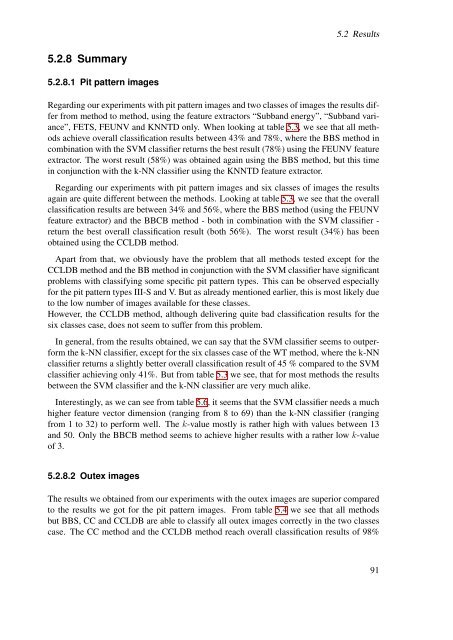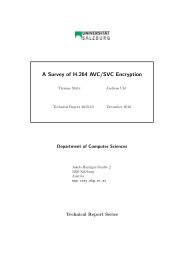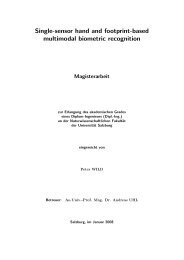Pit Pattern Classification in Colonoscopy using Wavelets - WaveLab
Pit Pattern Classification in Colonoscopy using Wavelets - WaveLab
Pit Pattern Classification in Colonoscopy using Wavelets - WaveLab
You also want an ePaper? Increase the reach of your titles
YUMPU automatically turns print PDFs into web optimized ePapers that Google loves.
5.2 Results<br />
5.2.8 Summary<br />
5.2.8.1 <strong>Pit</strong> pattern images<br />
Regard<strong>in</strong>g our experiments with pit pattern images and two classes of images the results differ<br />
from method to method, us<strong>in</strong>g the feature extractors “Subband energy”, “Subband variance”,<br />
FETS, FEUNV and KNNTD only. When look<strong>in</strong>g at table 5.3, we see that all methods<br />
achieve overall classification results between 43% and 78%, where the BBS method <strong>in</strong><br />
comb<strong>in</strong>ation with the SVM classifier returns the best result (78%) us<strong>in</strong>g the FEUNV feature<br />
extractor. The worst result (58%) was obta<strong>in</strong>ed aga<strong>in</strong> us<strong>in</strong>g the BBS method, but this time<br />
<strong>in</strong> conjunction with the k-NN classifier us<strong>in</strong>g the KNNTD feature extractor.<br />
Regard<strong>in</strong>g our experiments with pit pattern images and six classes of images the results<br />
aga<strong>in</strong> are quite different between the methods. Look<strong>in</strong>g at table 5.3, we see that the overall<br />
classification results are between 34% and 56%, where the BBS method (us<strong>in</strong>g the FEUNV<br />
feature extractor) and the BBCB method - both <strong>in</strong> comb<strong>in</strong>ation with the SVM classifier -<br />
return the best overall classification result (both 56%). The worst result (34%) has been<br />
obta<strong>in</strong>ed us<strong>in</strong>g the CCLDB method.<br />
Apart from that, we obviously have the problem that all methods tested except for the<br />
CCLDB method and the BB method <strong>in</strong> conjunction with the SVM classifier have significant<br />
problems with classify<strong>in</strong>g some specific pit pattern types. This can be observed especially<br />
for the pit pattern types III-S and V. But as already mentioned earlier, this is most likely due<br />
to the low number of images available for these classes.<br />
However, the CCLDB method, although deliver<strong>in</strong>g quite bad classification results for the<br />
six classes case, does not seem to suffer from this problem.<br />
In general, from the results obta<strong>in</strong>ed, we can say that the SVM classifier seems to outperform<br />
the k-NN classifier, except for the six classes case of the WT method, where the k-NN<br />
classifier returns a slightly better overall classification result of 45 % compared to the SVM<br />
classifier achiev<strong>in</strong>g only 41%. But from table 5.3 we see, that for most methods the results<br />
between the SVM classifier and the k-NN classifier are very much alike.<br />
Interest<strong>in</strong>gly, as we can see from table 5.6, it seems that the SVM classifier needs a much<br />
higher feature vector dimension (rang<strong>in</strong>g from 8 to 69) than the k-NN classifier (rang<strong>in</strong>g<br />
from 1 to 32) to perform well. The k-value mostly is rather high with values between 13<br />
and 50. Only the BBCB method seems to achieve higher results with a rather low k-value<br />
of 3.<br />
5.2.8.2 Outex images<br />
The results we obta<strong>in</strong>ed from our experiments with the outex images are superior compared<br />
to the results we got for the pit pattern images. From table 5.4 we see that all methods<br />
but BBS, CC and CCLDB are able to classify all outex images correctly <strong>in</strong> the two classes<br />
case. The CC method and the CCLDB method reach overall classification results of 98%<br />
91








